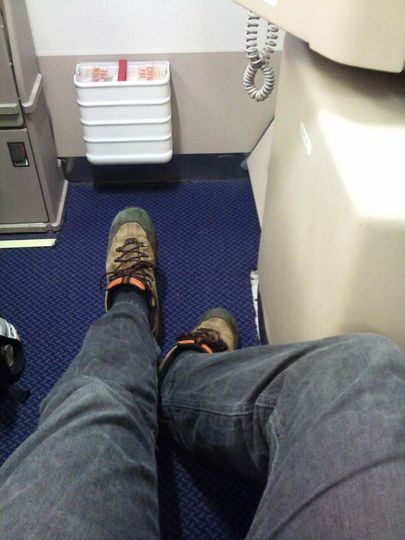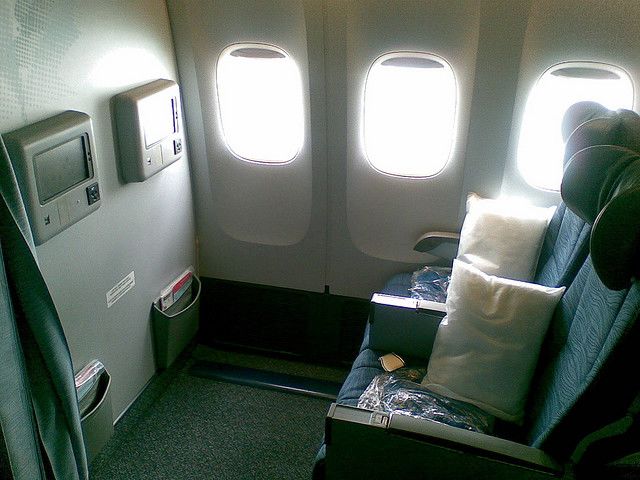While the world's economy seems to be getting back on track after the global financial crisis, many business travellers are still flying in economy class -- especially on shorter international trips.
Numerous companies that previously allowed business class travel downgraded to premium economy and the seats at the back of the plane during the recession. Even though salaries and bonuses have been unfrozen, many of the corporate travel benefits of flying in business class haven't returned.
For any business traveller, economy means that a flight is to be endured in discomfort rather than to be used as productive work time. And if you're tall, it's a painful exercise as the person in front of you jams their seat back into your knees.
So we've put together a few tips for picking a seat with extra legroom in economy to make your flight more comfortable -- and, if it means you can use your laptop when the person in front of you puts their seat back, even more productive.
Extra legroom might cost you an arm and, well, a leg
Many airlines, whether short-haul or long-haul, now charge for seating with extra legroom, including Qantas, Singapore Airlines, and British Airways. And it's not cheap: up to $300 for a flight from Australia to Europe.
Often, this fee can be paid for at the time of booking, which may mean that the charge can be included as part of an official economy class fare under corporate travel structures.
On some airlines, you can also pay for it at check-in if the flight looks full and you want to be sure of extra legroom. Virgin Atlantic even offers you the chance to upgrade to premium economy for a couple of hundred dollars more than the price for an exit row -- a real bargain, since their premium economy is great.
But is paying for extra legroom in economy worth the money? Only you -- and probably your knees -- can decide. Take a look at the various types of seat with extra legroom and see what you think.
Exit row seats
A frequent flyer favourite, exit rows have extra legroom to allow for faster escapes during an emergency.
On larger aircraft flying on long-distance or high-demand flights, exit rows are usually found at the front of each cabin section. On smaller aircraft, they're at the very front of the plane on the left (though this is business class on planes that have a premium cabin) and at the overwing exits.
Pro: Exit rows are great for tall people because there's either essentially unlimited legroom (like at the front of a Boeing 737 on the left hand side: seats 1A, 1B, 1C) or an extra six to eight inches (in Airbus A320 family and Boeing 737/757 planes at the exits over the wings). This is also particularly useful for being able to use a laptop without the danger of someone reclining backwards onto your screen.
Plus, if you're at the front of the cabin, you'll be earlier into immigration and baggage claim.
Con: Beware if you're on the portly side, though: many airlines refuse to allow passengers who need an extension seatbelt to sit in the exit row, and you may well be re-seated in a less desirable seat. The seats are also an inch or two narrower than regular seats, since the tray table needs to be in the side of your seat rather than hanging off the seat in front.
The exit row window seat on many wide-body planes (particularly the Boeing 747) may actually have less legroom than the middle or aisle seat. Since the housing for the emergency exit slide mechanism bulges out into the cabin, your leg closest to the wall probably has less seating than a regular seat.
Window seats at the exit row sometimes have legroom blocked by the housing for the emergency exit slide. (Picture: Karl Baron)
Bulkhead seats
The bulkhead is what airlines call the wall separating one cabin from another, so bulkhead seats have extra space because there's no seat in front of you.
On narrow-body aircraft, the only bulkhead is usually at the very front of the plane on the right, although the row number is either 1 or 2, seats D, E and F. This is in business class on those planes that offer business class. On wide-body aircraft, bulkheads are found at the front of cabin sections in the middle seats. Being at the front of the cabin is also useful: it's always better to be at the front of the herd heading for arrivals.
There is a debate among business travellers about the desirability of bulkhead seats, though.
Pro: it's easier to get up and out from the window and middle seats with minimal disruption to people in the aisle. Plus, nobody will be reclining into your knees or your laptop.
Con: On the other hand, the actual amount of room that you have to extend your feet is less than in a regular seat, where your feet would tuck under the seat in front of you. The seats are often an inch or two narrower than regular seats because your tray table unfolds from the side of your seat rather than from the seat in front of you.
Bulkhead seats are also most likely to contain families with babies on long-haul flights, because the bassinet (crib) tables fold down from the bulkhead. So earplugs or noise-cancelling headphones are best kept close at hand.
Bulkhead seats are a good choice for extra legroom and nobody reclining back into you. (Picture: Andrew Currie)
The very back of the plane
Sitting at the very back of the plane is less popular because you're last off when it lands, but it also means that fewer people want to sit there. You're less likely to have someone sitting next to you, so you can extend your legs sideways for more room.
Pro: often, airlines will block off the final row of the plane for last-minute seating changes on the plane. Once everyone's on board they'll sometimes pull any particularly squashed-looking passengers from rows nearby, which means you may end up with a spare seat next to you.
And at the very back of the largest aircraft, the cabin narrows so that there are fewer seats across. Boeing 747s, for instance, end up with two seats by the window instead of three in the last two or three rows. This also means that the window seat has a good six to eight inches of extra elbow room. Plus, these seats don't come at any extra cost.
Con: the very last row sometimes doesn't recline. There's usually a fair amount of noise and activity from the galley kitchen and the set of loos at the back of the plane. Engine noise and vibration makes it louder than the front of the plane. And it can just be plain depressing to stare ahead at rank after rank of squashed economy seating.
At the back of many larger long-haul aircraft, the body of the plane narrows, giving fewer seats per row and some extra elbow room. (Picture: Ben Wynn)
"Economy plus" zones: just economy, but with more legroom
Some airlines have a specific zone in their economy class cabins with extra legroom. Seats in these areas are often handed out free to top-tier frequent flyers, but some airlines also let travellers without the right colour frequent flyer card purchase them for a fee of between $50-200, depending on flight length.
KLM and Delta's Economy Comfort, Air New Zealand's Space+ and United's Economy Plus all fall into this category, and are often called "premium economy" seating.
But beware: they're not the wider premium economy seats with better features and service from Qantas, Virgin Atlantic, V Australia, British Airways and others. "Economy plus" is just economy with more legroom.
Avoiding seats with less legroom
The last row in many planes has reduced or no recline, since various things (including first aid kits and various cabin service tools) are stored behind it.
On smaller aircraft like Boeing 737s and Airbus A320s, the seats immediately in front of the overwing exit rows frequently don't recline, so you'll feel more squashed if the person in front of you puts their seat back.
Business travellers looking for extra legroom should definitely skip these seats.




30 Jun 2011
Total posts 49
I noticed a very 'portly' gentlemen sitting in row 1 recently. Cabin crew moved him to row 2, presumeably to free up the exit. However, the crew (Virgin) where then unfailingly polite and accommodating to the chap from that point, ensuring he was comfortable for the rest of the flight. Nice work.
Hi Guest, join in the discussion on How to get extra legroom in economy class